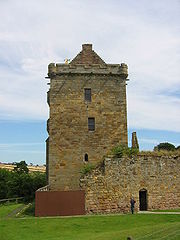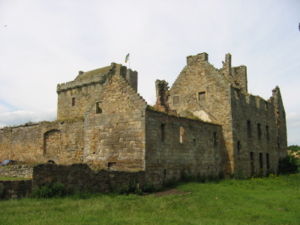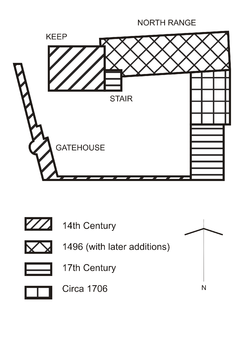
Balgonie Castle
Encyclopedia
Balgonie Castle is located on the south bank of the River Leven
near Milton of Balgonie
, 3.5 kilometres (2.2 mi) east of Glenrothes
, Fife
, Scotland
. The keep dates from the 14th century, and the remaining structures were added piecemeal until the 18th century. The keep has been recently restored, although other parts of the castle are roofless ruins.
at the north-west corner. The lands and the castle were left to a daughter, who married Sir Robert Lundie, who extended the castle in 1496, following his appointment as Lord High Treasurer
of Scotland. Sir Robert built a two-storey range of buildings to the east of the keep, enlarging the accommodation with a long hall and a solar
. This range incorporated an earlier corner tower and the 14th century chapel.James IV
visited Balgonie during the works, and ordered 20 shillings to be given to the masons.
 In 1627 the castle was sold to the Boswells, who sold it on in 1635 to Sir Alexander Leslie
In 1627 the castle was sold to the Boswells, who sold it on in 1635 to Sir Alexander Leslie
, a Scottish soldier who had fought for the Swedish army during the Thirty Years' War
(1618-1648), rising to the rank of Field Marshal
, and who led the Covenanter
s during the Scottish Bishops Wars. Leslie was created Lord Balgonie and Earl of Leven
in 1641, and finally retired in 1654. He carried out further improvement of his home, adding a two-storey building at the south-east corner of the courtyard. The initials FSAL and DAR, for Field Marshal Sir Alexander Leslie, and his wife Dame Agnes Renton, were found inscribed within the south-east block, suggesting that this was built prior to Leslie's elevation to the peerage. He also rebuilt the late 15th century north range with an extra storey, and laid out a park around the castle, remnants of which remain.
The next additions were carried out by John Leslie, 7th Earl of Rothes
, who disputed the earldom of Leven with David Melville
following the death of the second earl in 1664. Lord Rothes, with the aid of John Mylne junior
, the king's master mason, built a grand stair linking the keep and north range, where previously a wooden bridge stood. On his death in 1681 David Melville inherited Balgonie, along with the earldom of Leven. He too added a range of buildings in 1706, this time a three-storey section linking the north range with the south-east block. The work was completed by master mason Gilbert Smith.
Rob Roy MacGregor captured Balgonie Castle during a raid in 1716, although the castle was soon returned to the Melvilles. David Melville, 6th Earl of Leven
made minor improvements in the 1720s, including the insertion of sash window
s. Further buildings were also added within the courtyard.
 In 1824 the castle was sold to James Balfour of Whittingehame
In 1824 the castle was sold to James Balfour of Whittingehame
, father of James Maitland Balfour
, and grandfather of Arthur Balfour
, who served as British Prime Minister from 1902-1905. He was unable to arrest the decay which was advancing, and in the mid nineteenth century the roofs were removed to avoid paying tax on the property. Much vandalism occurred in the 1960s, and it was not until 1971 that restoration of the castle, then owned by David Maxwell, began. Work continued through the 1970s and 1980s, aided by European funding, as part of European Architectural Heritage Year, in 1975. The keep and chapel have now been fully restored, and the castle is once again lived in by its current owner and laird, Raymond Morris, and his family. The castle is open to the public, and the restored chapel and great hall can be hired for events such as weddings. The current owners have expressed their intent to continue the restoration of the entire building.
 The castle is still entered via the 15th century gatehouse. This is semi-ruinous above ground level, but a guardroom and prison can be seen within. The gate opens onto a courtyard, containing a well, around which the buildings are arranged.
The castle is still entered via the 15th century gatehouse. This is semi-ruinous above ground level, but a guardroom and prison can be seen within. The gate opens onto a courtyard, containing a well, around which the buildings are arranged.
The ground and first floors of the keep are vaulted, the first floor containing the hall, which unusually had no great fireplace. This would originally have been entered via a moveable timber stair, prior to the construction of the present stone stair. Above the hall are two further floors, each with a fireplace and connected by a turnpike stair. The keep is topped by a pitched roof with crow stepped gables. Outside, the parapet walk and cannon spouts are of 17th century origin, and contemporary with the enlarged windows. Some of the smaller trefoil-headed original windows survive.
In the basement of the north range is the vaulted chapel, although the remainder of the range, and the east buildings, are roofless. Walls and chimney stacks remain. The remains of earlier buildings within the courtyard were uncovered during excavations in 1978. It appears that these were demolished in the early 17th century to allow rebuilding.
Beyond the castle walls, the extensive boundary walls of the deer park survive, although damaged in parts. Large mature trees remain from the 17th century landscaping.
River Leven, Fife
The River Leven is a river in Fife in Scotland. It flows from Loch Leven into the Firth of Forth at the town of Leven. The river is home to brown trout and hosts a run of sea trout and atlantic salmon...
near Milton of Balgonie
Milton of Balgonie
Milton of Balgonie is a small village in central Fife, Scotland. It is situated 2 miles to the east of Glenrothes between the nearby villages of Markinch and Coaltown of Balgonie to the west and Windygates to the east. Nearby attractions include Balgonie Castle which is situated between Milton and...
, 3.5 kilometres (2.2 mi) east of Glenrothes
Glenrothes
Glenrothes is a large town situated in the heart of Fife, in east-central Scotland. It is located approximately from both Edinburgh, which lies to the south and Dundee to the north. The town had an estimated population of 38,750 in 2008, making Glenrothes the third largest settlement in Fife...
, Fife
Fife
Fife is a council area and former county of Scotland. It is situated between the Firth of Tay and the Firth of Forth, with inland boundaries to Perth and Kinross and Clackmannanshire...
, Scotland
Scotland
Scotland is a country that is part of the United Kingdom. Occupying the northern third of the island of Great Britain, it shares a border with England to the south and is bounded by the North Sea to the east, the Atlantic Ocean to the north and west, and the North Channel and Irish Sea to the...
. The keep dates from the 14th century, and the remaining structures were added piecemeal until the 18th century. The keep has been recently restored, although other parts of the castle are roofless ruins.
History
The lands of Balgonie were held by the Sibbalds from at least 1246. Probably in the 1360s, the Sibbalds built a barmkin, or fortified courtyard, with a tower houseTower house
A tower house is a particular type of stone structure, built for defensive purposes as well as habitation.-History:Tower houses began to appear in the Middle Ages, especially in mountain or limited access areas, in order to command and defend strategic points with reduced forces...
at the north-west corner. The lands and the castle were left to a daughter, who married Sir Robert Lundie, who extended the castle in 1496, following his appointment as Lord High Treasurer
Lord High Treasurer
The post of Lord High Treasurer or Lord Treasurer was an English government position and has been a British government position since the Act of Union of 1707. A holder of the post would be the third highest ranked Great Officer of State, below the Lord High Chancellor and above the Lord President...
of Scotland. Sir Robert built a two-storey range of buildings to the east of the keep, enlarging the accommodation with a long hall and a solar
Solar (room)
The solar was a room in many English and French medieval manor houses, great houses and castles, generally situated on an upper storey, designed as the family's private living and sleeping quarters...
. This range incorporated an earlier corner tower and the 14th century chapel.James IV
James IV of Scotland
James IV was King of Scots from 11 June 1488 to his death. He is generally regarded as the most successful of the Stewart monarchs of Scotland, but his reign ended with the disastrous defeat at the Battle of Flodden Field, where he became the last monarch from not only Scotland, but also from all...
visited Balgonie during the works, and ordered 20 shillings to be given to the masons.

Alexander Leslie, 1st Earl of Leven
Alexander Leslie, 1st Earl of Leven was a Scottish soldier in Dutch, Swedish and Scottish service. Born illegitimate and raised as a foster child, he subsequently advanced to the rank of a Dutch captain, a Swedish Field Marshal, and in Scotland became lord general in command of the Covenanters,...
, a Scottish soldier who had fought for the Swedish army during the Thirty Years' War
Thirty Years' War
The Thirty Years' War was fought primarily in what is now Germany, and at various points involved most countries in Europe. It was one of the most destructive conflicts in European history....
(1618-1648), rising to the rank of Field Marshal
Field Marshal
Field Marshal is a military rank. Traditionally, it is the highest military rank in an army.-Etymology:The origin of the rank of field marshal dates to the early Middle Ages, originally meaning the keeper of the king's horses , from the time of the early Frankish kings.-Usage and hierarchical...
, and who led the Covenanter
Covenanter
The Covenanters were a Scottish Presbyterian movement that played an important part in the history of Scotland, and to a lesser extent in that of England and Ireland, during the 17th century...
s during the Scottish Bishops Wars. Leslie was created Lord Balgonie and Earl of Leven
Earl of Leven
Earl of Leven is a title in the Peerage of Scotland. It was created in 1641 for Alexander Leslie. He was succeeded by his grandson Alexander, who was in turn followed by his daughters Margaret and Catherine...
in 1641, and finally retired in 1654. He carried out further improvement of his home, adding a two-storey building at the south-east corner of the courtyard. The initials FSAL and DAR, for Field Marshal Sir Alexander Leslie, and his wife Dame Agnes Renton, were found inscribed within the south-east block, suggesting that this was built prior to Leslie's elevation to the peerage. He also rebuilt the late 15th century north range with an extra storey, and laid out a park around the castle, remnants of which remain.
The next additions were carried out by John Leslie, 7th Earl of Rothes
John Leslie, 1st Duke of Rothes
John Leslie , son of John Leslie, 6th Earl of Rothes, was the 7th Earl of Rothes and 1st Duke of Rothes. He was a descendant of Princess Beatrix, sister of King Malcolm III of Scotland...
, who disputed the earldom of Leven with David Melville
David Melville, 3rd Earl of Leven
David Leslie-Melville, 3rd Earl of Leven and 2nd Earl of Melville was a Scots aristocrat, politician, and soldier.The third son of George Melville, 1st Earl of Melville and his second wife Catherine Leslie-Melville, he shared the Whig political and the Presbyterian religious sympathies of his...
following the death of the second earl in 1664. Lord Rothes, with the aid of John Mylne junior
John Mylne (1611-1667)
John Mylne , sometimes known as "John Mylne junior", or "the Younger", was a Scottish master mason and architect, who served as Master Mason to the Crown of Scotland. Born in Perth, he was the son of John Mylne, master mason, and Isobel Wilson.Practising as a stonemason, he also took on the role of...
, the king's master mason, built a grand stair linking the keep and north range, where previously a wooden bridge stood. On his death in 1681 David Melville inherited Balgonie, along with the earldom of Leven. He too added a range of buildings in 1706, this time a three-storey section linking the north range with the south-east block. The work was completed by master mason Gilbert Smith.
Rob Roy MacGregor captured Balgonie Castle during a raid in 1716, although the castle was soon returned to the Melvilles. David Melville, 6th Earl of Leven
David Melville, 6th Earl of Leven
David Melville, 6th Earl of Leven was the son of Alexander Melville, 5th Earl of Leven.Grand Master of Scottish Freemasons 1759-61; Deputy Governor of the Bank of Scotland; a Lord of Police 1772-82; High Commissioner to the General Assembly of the Church of Scotland 1783-1801On 29 July 1747, he...
made minor improvements in the 1720s, including the insertion of sash window
Sash window
A sash window or hung sash window is made of one or more movable panels or "sashes" that form a frame to hold panes of glass, which are often separated from other panes by narrow muntins...
s. Further buildings were also added within the courtyard.

Whittingehame
Whittingehame is a parish with a small village in East Lothian, Scotland, about halfway between Haddington and Dunbar, and near East Linton. The area is on the slopes of the Lammermuir Hills...
, father of James Maitland Balfour
James Maitland Balfour
James Maitland Balfour , of Whittinghame, Berwickshire, was a Scottish Member of Parliament. He was the father of Prime Minister Arthur Balfour, 1st Earl of Balfour....
, and grandfather of Arthur Balfour
Arthur Balfour
Arthur James Balfour, 1st Earl of Balfour, KG, OM, PC, DL was a British Conservative politician and statesman...
, who served as British Prime Minister from 1902-1905. He was unable to arrest the decay which was advancing, and in the mid nineteenth century the roofs were removed to avoid paying tax on the property. Much vandalism occurred in the 1960s, and it was not until 1971 that restoration of the castle, then owned by David Maxwell, began. Work continued through the 1970s and 1980s, aided by European funding, as part of European Architectural Heritage Year, in 1975. The keep and chapel have now been fully restored, and the castle is once again lived in by its current owner and laird, Raymond Morris, and his family. The castle is open to the public, and the restored chapel and great hall can be hired for events such as weddings. The current owners have expressed their intent to continue the restoration of the entire building.
The castle

The ground and first floors of the keep are vaulted, the first floor containing the hall, which unusually had no great fireplace. This would originally have been entered via a moveable timber stair, prior to the construction of the present stone stair. Above the hall are two further floors, each with a fireplace and connected by a turnpike stair. The keep is topped by a pitched roof with crow stepped gables. Outside, the parapet walk and cannon spouts are of 17th century origin, and contemporary with the enlarged windows. Some of the smaller trefoil-headed original windows survive.
In the basement of the north range is the vaulted chapel, although the remainder of the range, and the east buildings, are roofless. Walls and chimney stacks remain. The remains of earlier buildings within the courtyard were uncovered during excavations in 1978. It appears that these were demolished in the early 17th century to allow rebuilding.
Beyond the castle walls, the extensive boundary walls of the deer park survive, although damaged in parts. Large mature trees remain from the 17th century landscaping.
Hauntings
Several hauntings have been reported within the castle. One spectre, nicknamed 'Green Jeanie', is said to be the ghost of one of the Lundie occupants. A 17th century soldier, a dog, and a hooded man have also been claimed to be seen. A skeleton was found in the floor of the great hall, during works in 1912.External links
- Balgonie Castle website
- "A Scotsman's Castle is his Home", interview with Stuart Morris of Balgonie, in the Birmingham Magazine, 1997. Accessed 1 August 2006.

